Business Law Assignment: Misrepresentation and Negligence Analysis
VerifiedAdded on 2021/06/16
|9
|2356
|138
Homework Assignment
AI Summary
This business law assignment provides a detailed analysis of two legal issues: misrepresentation and negligence. The first section examines a scenario where a seller allegedly misrepresented the profitability of a business, focusing on the elements required to establish misrepresentation, drawing on case law such as Kalabakas v Chubb Insurance Company of Australia Ltd, Bisset v Wilkinson, and Smith v Land & House Property Corp. The analysis considers whether the buyer had the opportunity to verify the information and the concept of fraudulent misrepresentation. The second part of the assignment addresses a negligence claim against a cola manufacturer, exploring the duty of care, breach of duty, and causation, with reference to landmark cases like Donoghue v Stevenson, Caparo Industries plc v Dickman, and Grant v Australian Knitting Mills. The assignment applies these legal principles to the provided factual scenarios, concluding with judgments on the liability of the parties involved. The assignment uses Australian law and relevant legislation such as the Misrepresentation Act 1972 and Civil Liability Act 2002 to support its arguments.
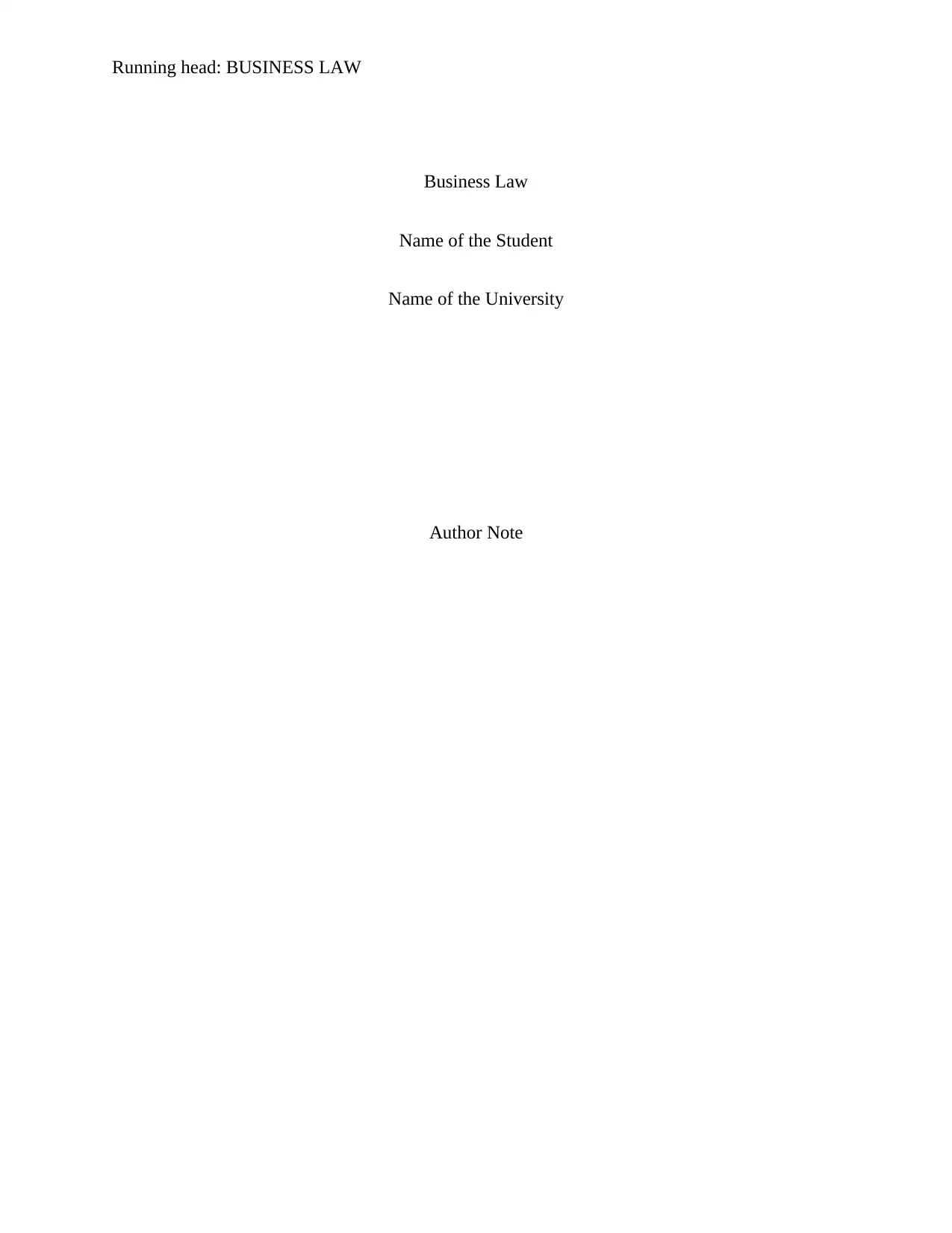
Running head: BUSINESS LAW
Business Law
Name of the Student
Name of the University
Author Note
Business Law
Name of the Student
Name of the University
Author Note
Paraphrase This Document
Need a fresh take? Get an instant paraphrase of this document with our AI Paraphraser
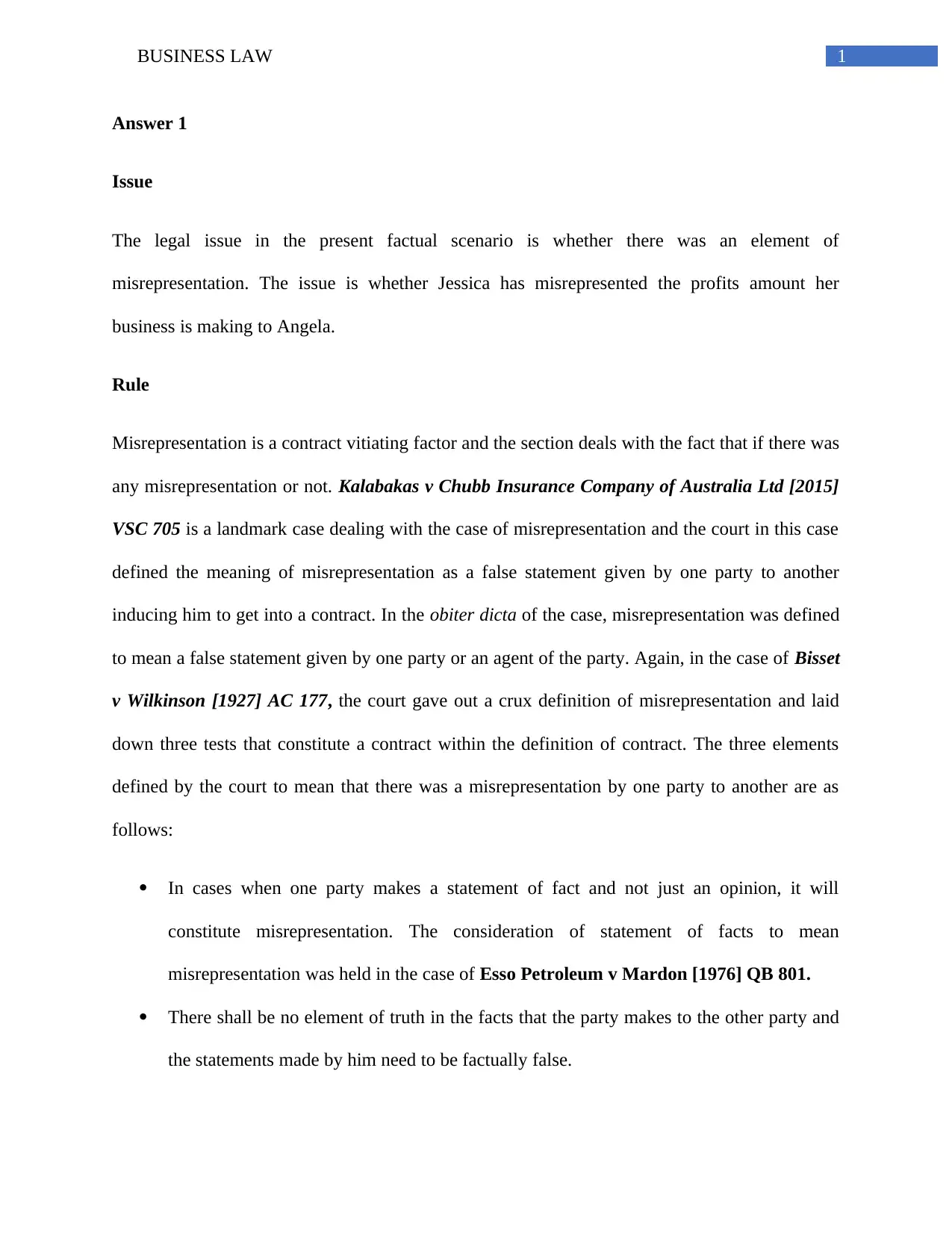
1BUSINESS LAW
Answer 1
Issue
The legal issue in the present factual scenario is whether there was an element of
misrepresentation. The issue is whether Jessica has misrepresented the profits amount her
business is making to Angela.
Rule
Misrepresentation is a contract vitiating factor and the section deals with the fact that if there was
any misrepresentation or not. Kalabakas v Chubb Insurance Company of Australia Ltd [2015]
VSC 705 is a landmark case dealing with the case of misrepresentation and the court in this case
defined the meaning of misrepresentation as a false statement given by one party to another
inducing him to get into a contract. In the obiter dicta of the case, misrepresentation was defined
to mean a false statement given by one party or an agent of the party. Again, in the case of Bisset
v Wilkinson [1927] AC 177, the court gave out a crux definition of misrepresentation and laid
down three tests that constitute a contract within the definition of contract. The three elements
defined by the court to mean that there was a misrepresentation by one party to another are as
follows:
In cases when one party makes a statement of fact and not just an opinion, it will
constitute misrepresentation. The consideration of statement of facts to mean
misrepresentation was held in the case of Esso Petroleum v Mardon [1976] QB 801.
There shall be no element of truth in the facts that the party makes to the other party and
the statements made by him need to be factually false.
Answer 1
Issue
The legal issue in the present factual scenario is whether there was an element of
misrepresentation. The issue is whether Jessica has misrepresented the profits amount her
business is making to Angela.
Rule
Misrepresentation is a contract vitiating factor and the section deals with the fact that if there was
any misrepresentation or not. Kalabakas v Chubb Insurance Company of Australia Ltd [2015]
VSC 705 is a landmark case dealing with the case of misrepresentation and the court in this case
defined the meaning of misrepresentation as a false statement given by one party to another
inducing him to get into a contract. In the obiter dicta of the case, misrepresentation was defined
to mean a false statement given by one party or an agent of the party. Again, in the case of Bisset
v Wilkinson [1927] AC 177, the court gave out a crux definition of misrepresentation and laid
down three tests that constitute a contract within the definition of contract. The three elements
defined by the court to mean that there was a misrepresentation by one party to another are as
follows:
In cases when one party makes a statement of fact and not just an opinion, it will
constitute misrepresentation. The consideration of statement of facts to mean
misrepresentation was held in the case of Esso Petroleum v Mardon [1976] QB 801.
There shall be no element of truth in the facts that the party makes to the other party and
the statements made by him need to be factually false.
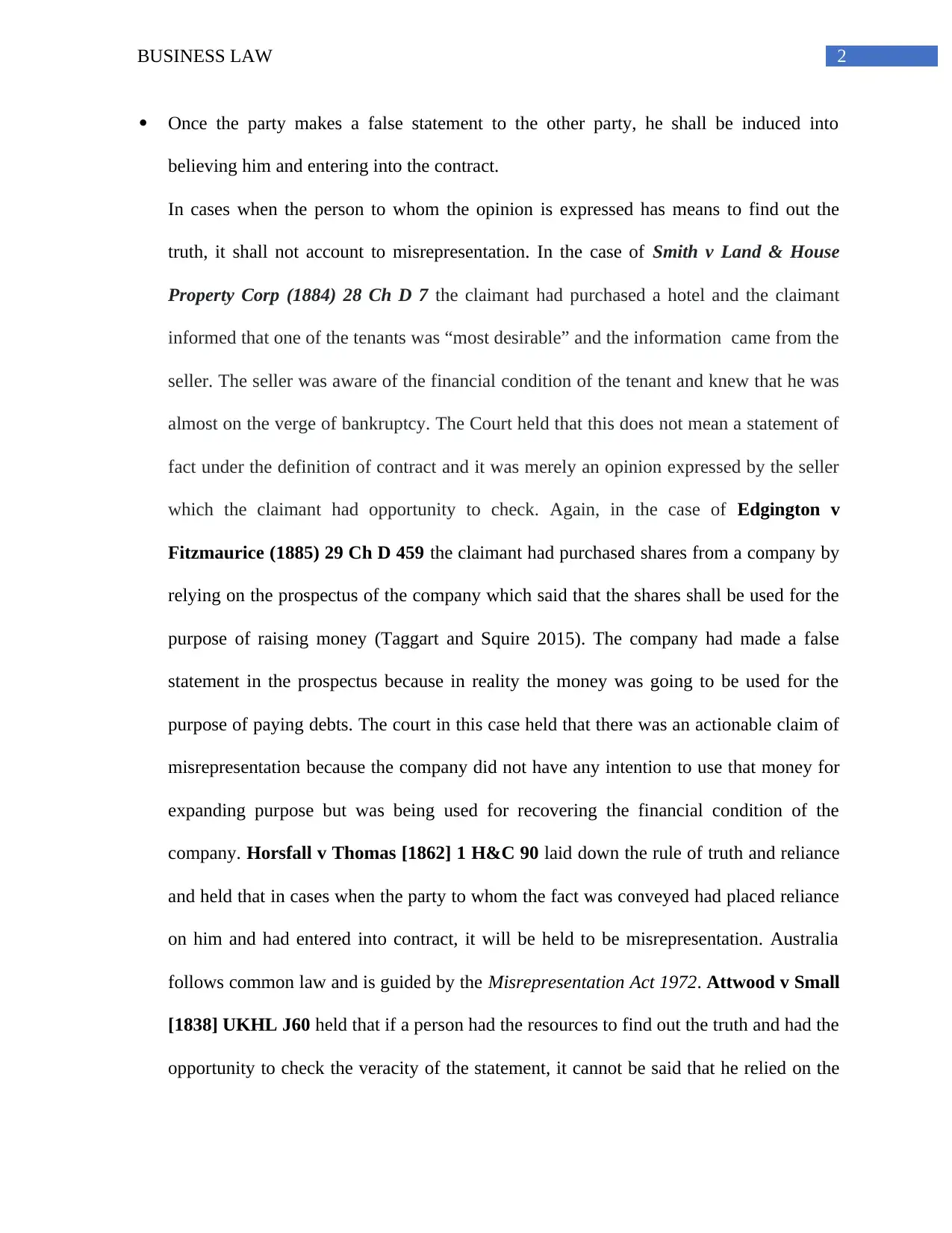
2BUSINESS LAW
Once the party makes a false statement to the other party, he shall be induced into
believing him and entering into the contract.
In cases when the person to whom the opinion is expressed has means to find out the
truth, it shall not account to misrepresentation. In the case of Smith v Land & House
Property Corp (1884) 28 Ch D 7 the claimant had purchased a hotel and the claimant
informed that one of the tenants was “most desirable” and the information came from the
seller. The seller was aware of the financial condition of the tenant and knew that he was
almost on the verge of bankruptcy. The Court held that this does not mean a statement of
fact under the definition of contract and it was merely an opinion expressed by the seller
which the claimant had opportunity to check. Again, in the case of Edgington v
Fitzmaurice (1885) 29 Ch D 459 the claimant had purchased shares from a company by
relying on the prospectus of the company which said that the shares shall be used for the
purpose of raising money (Taggart and Squire 2015). The company had made a false
statement in the prospectus because in reality the money was going to be used for the
purpose of paying debts. The court in this case held that there was an actionable claim of
misrepresentation because the company did not have any intention to use that money for
expanding purpose but was being used for recovering the financial condition of the
company. Horsfall v Thomas [1862] 1 H&C 90 laid down the rule of truth and reliance
and held that in cases when the party to whom the fact was conveyed had placed reliance
on him and had entered into contract, it will be held to be misrepresentation. Australia
follows common law and is guided by the Misrepresentation Act 1972. Attwood v Small
[1838] UKHL J60 held that if a person had the resources to find out the truth and had the
opportunity to check the veracity of the statement, it cannot be said that he relied on the
Once the party makes a false statement to the other party, he shall be induced into
believing him and entering into the contract.
In cases when the person to whom the opinion is expressed has means to find out the
truth, it shall not account to misrepresentation. In the case of Smith v Land & House
Property Corp (1884) 28 Ch D 7 the claimant had purchased a hotel and the claimant
informed that one of the tenants was “most desirable” and the information came from the
seller. The seller was aware of the financial condition of the tenant and knew that he was
almost on the verge of bankruptcy. The Court held that this does not mean a statement of
fact under the definition of contract and it was merely an opinion expressed by the seller
which the claimant had opportunity to check. Again, in the case of Edgington v
Fitzmaurice (1885) 29 Ch D 459 the claimant had purchased shares from a company by
relying on the prospectus of the company which said that the shares shall be used for the
purpose of raising money (Taggart and Squire 2015). The company had made a false
statement in the prospectus because in reality the money was going to be used for the
purpose of paying debts. The court in this case held that there was an actionable claim of
misrepresentation because the company did not have any intention to use that money for
expanding purpose but was being used for recovering the financial condition of the
company. Horsfall v Thomas [1862] 1 H&C 90 laid down the rule of truth and reliance
and held that in cases when the party to whom the fact was conveyed had placed reliance
on him and had entered into contract, it will be held to be misrepresentation. Australia
follows common law and is guided by the Misrepresentation Act 1972. Attwood v Small
[1838] UKHL J60 held that if a person had the resources to find out the truth and had the
opportunity to check the veracity of the statement, it cannot be said that he relied on the
⊘ This is a preview!⊘
Do you want full access?
Subscribe today to unlock all pages.

Trusted by 1+ million students worldwide
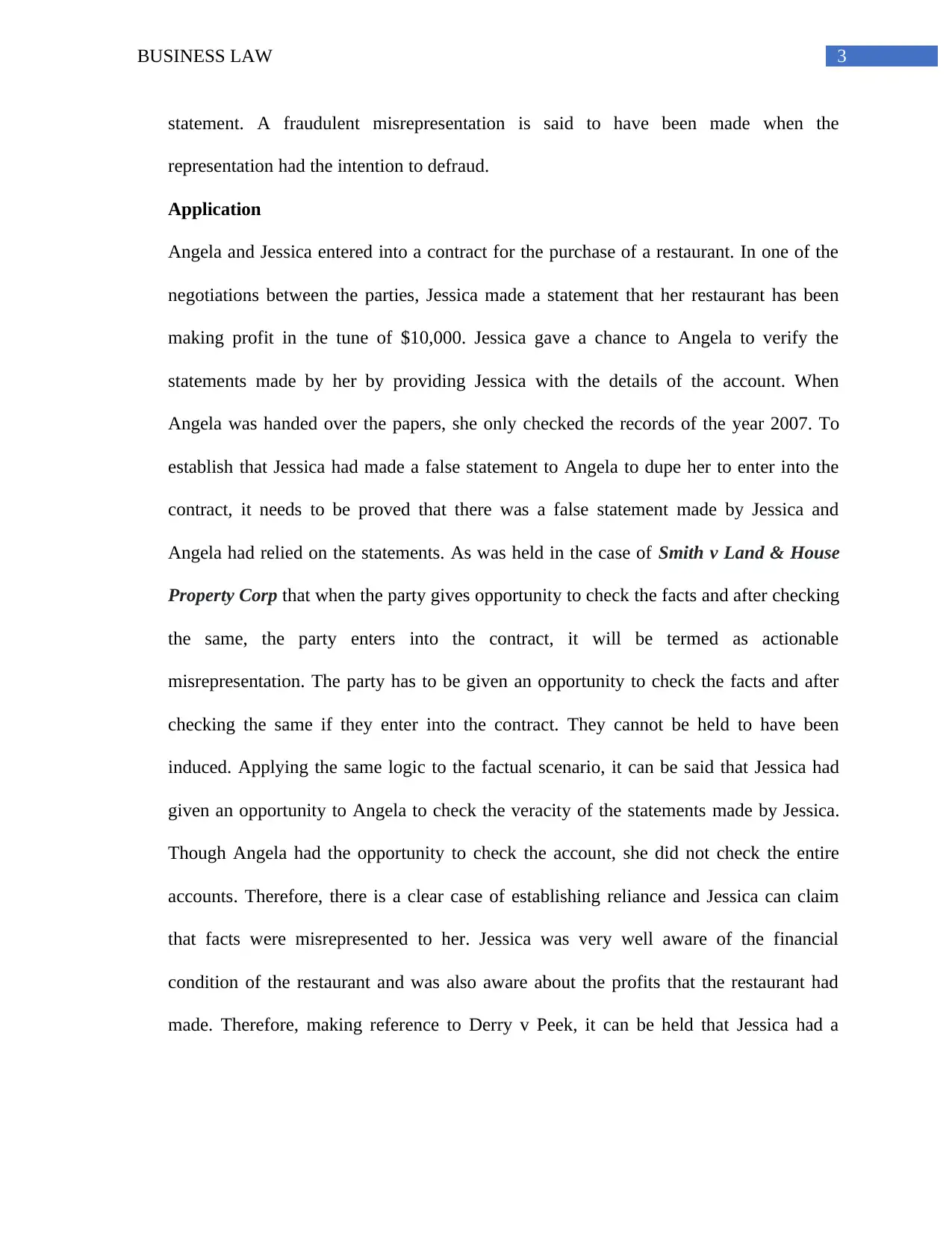
3BUSINESS LAW
statement. A fraudulent misrepresentation is said to have been made when the
representation had the intention to defraud.
Application
Angela and Jessica entered into a contract for the purchase of a restaurant. In one of the
negotiations between the parties, Jessica made a statement that her restaurant has been
making profit in the tune of $10,000. Jessica gave a chance to Angela to verify the
statements made by her by providing Jessica with the details of the account. When
Angela was handed over the papers, she only checked the records of the year 2007. To
establish that Jessica had made a false statement to Angela to dupe her to enter into the
contract, it needs to be proved that there was a false statement made by Jessica and
Angela had relied on the statements. As was held in the case of Smith v Land & House
Property Corp that when the party gives opportunity to check the facts and after checking
the same, the party enters into the contract, it will be termed as actionable
misrepresentation. The party has to be given an opportunity to check the facts and after
checking the same if they enter into the contract. They cannot be held to have been
induced. Applying the same logic to the factual scenario, it can be said that Jessica had
given an opportunity to Angela to check the veracity of the statements made by Jessica.
Though Angela had the opportunity to check the account, she did not check the entire
accounts. Therefore, there is a clear case of establishing reliance and Jessica can claim
that facts were misrepresented to her. Jessica was very well aware of the financial
condition of the restaurant and was also aware about the profits that the restaurant had
made. Therefore, making reference to Derry v Peek, it can be held that Jessica had a
statement. A fraudulent misrepresentation is said to have been made when the
representation had the intention to defraud.
Application
Angela and Jessica entered into a contract for the purchase of a restaurant. In one of the
negotiations between the parties, Jessica made a statement that her restaurant has been
making profit in the tune of $10,000. Jessica gave a chance to Angela to verify the
statements made by her by providing Jessica with the details of the account. When
Angela was handed over the papers, she only checked the records of the year 2007. To
establish that Jessica had made a false statement to Angela to dupe her to enter into the
contract, it needs to be proved that there was a false statement made by Jessica and
Angela had relied on the statements. As was held in the case of Smith v Land & House
Property Corp that when the party gives opportunity to check the facts and after checking
the same, the party enters into the contract, it will be termed as actionable
misrepresentation. The party has to be given an opportunity to check the facts and after
checking the same if they enter into the contract. They cannot be held to have been
induced. Applying the same logic to the factual scenario, it can be said that Jessica had
given an opportunity to Angela to check the veracity of the statements made by Jessica.
Though Angela had the opportunity to check the account, she did not check the entire
accounts. Therefore, there is a clear case of establishing reliance and Jessica can claim
that facts were misrepresented to her. Jessica was very well aware of the financial
condition of the restaurant and was also aware about the profits that the restaurant had
made. Therefore, making reference to Derry v Peek, it can be held that Jessica had a
Paraphrase This Document
Need a fresh take? Get an instant paraphrase of this document with our AI Paraphraser
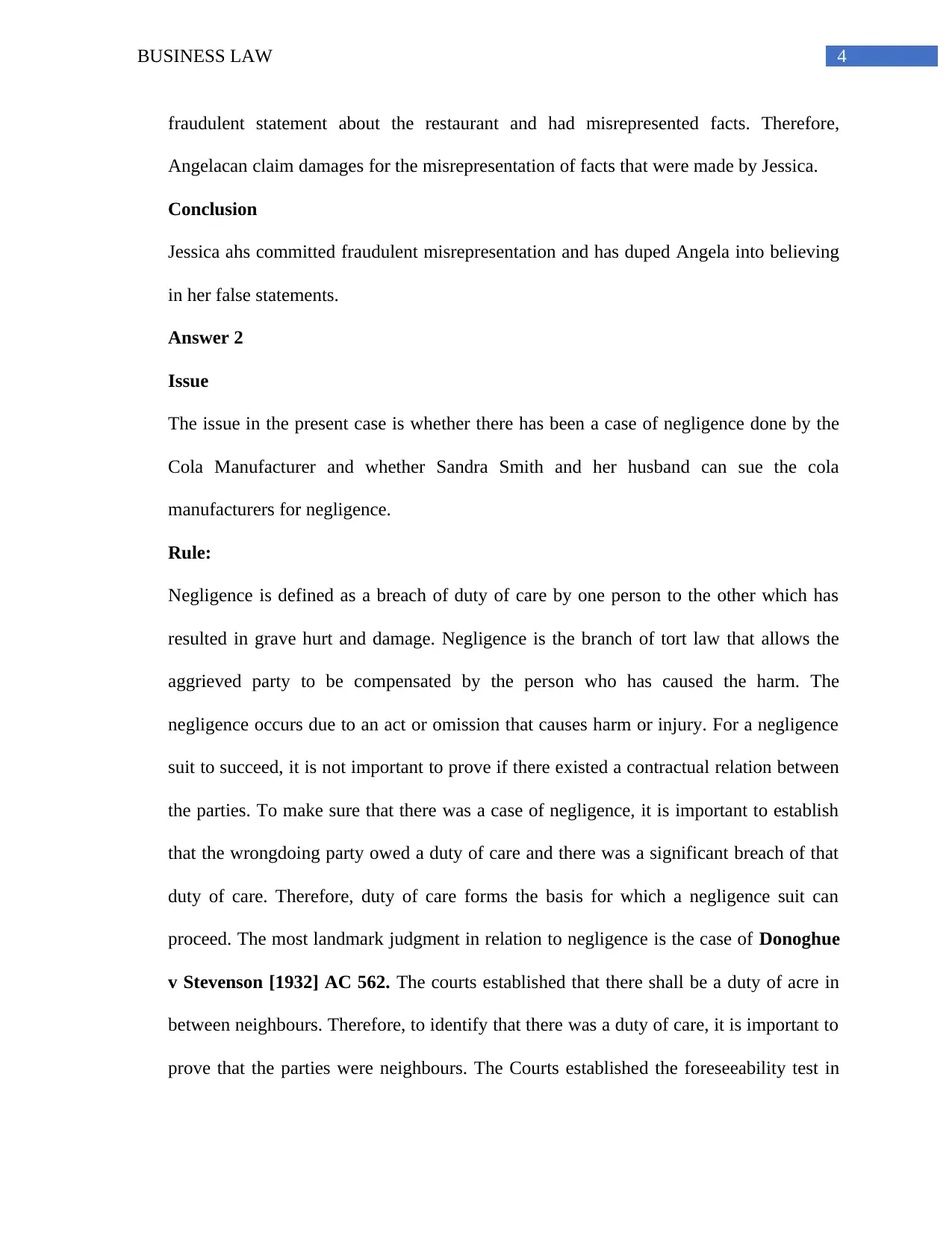
4BUSINESS LAW
fraudulent statement about the restaurant and had misrepresented facts. Therefore,
Angelacan claim damages for the misrepresentation of facts that were made by Jessica.
Conclusion
Jessica ahs committed fraudulent misrepresentation and has duped Angela into believing
in her false statements.
Answer 2
Issue
The issue in the present case is whether there has been a case of negligence done by the
Cola Manufacturer and whether Sandra Smith and her husband can sue the cola
manufacturers for negligence.
Rule:
Negligence is defined as a breach of duty of care by one person to the other which has
resulted in grave hurt and damage. Negligence is the branch of tort law that allows the
aggrieved party to be compensated by the person who has caused the harm. The
negligence occurs due to an act or omission that causes harm or injury. For a negligence
suit to succeed, it is not important to prove if there existed a contractual relation between
the parties. To make sure that there was a case of negligence, it is important to establish
that the wrongdoing party owed a duty of care and there was a significant breach of that
duty of care. Therefore, duty of care forms the basis for which a negligence suit can
proceed. The most landmark judgment in relation to negligence is the case of Donoghue
v Stevenson [1932] AC 562. The courts established that there shall be a duty of acre in
between neighbours. Therefore, to identify that there was a duty of care, it is important to
prove that the parties were neighbours. The Courts established the foreseeability test in
fraudulent statement about the restaurant and had misrepresented facts. Therefore,
Angelacan claim damages for the misrepresentation of facts that were made by Jessica.
Conclusion
Jessica ahs committed fraudulent misrepresentation and has duped Angela into believing
in her false statements.
Answer 2
Issue
The issue in the present case is whether there has been a case of negligence done by the
Cola Manufacturer and whether Sandra Smith and her husband can sue the cola
manufacturers for negligence.
Rule:
Negligence is defined as a breach of duty of care by one person to the other which has
resulted in grave hurt and damage. Negligence is the branch of tort law that allows the
aggrieved party to be compensated by the person who has caused the harm. The
negligence occurs due to an act or omission that causes harm or injury. For a negligence
suit to succeed, it is not important to prove if there existed a contractual relation between
the parties. To make sure that there was a case of negligence, it is important to establish
that the wrongdoing party owed a duty of care and there was a significant breach of that
duty of care. Therefore, duty of care forms the basis for which a negligence suit can
proceed. The most landmark judgment in relation to negligence is the case of Donoghue
v Stevenson [1932] AC 562. The courts established that there shall be a duty of acre in
between neighbours. Therefore, to identify that there was a duty of care, it is important to
prove that the parties were neighbours. The Courts established the foreseeability test in
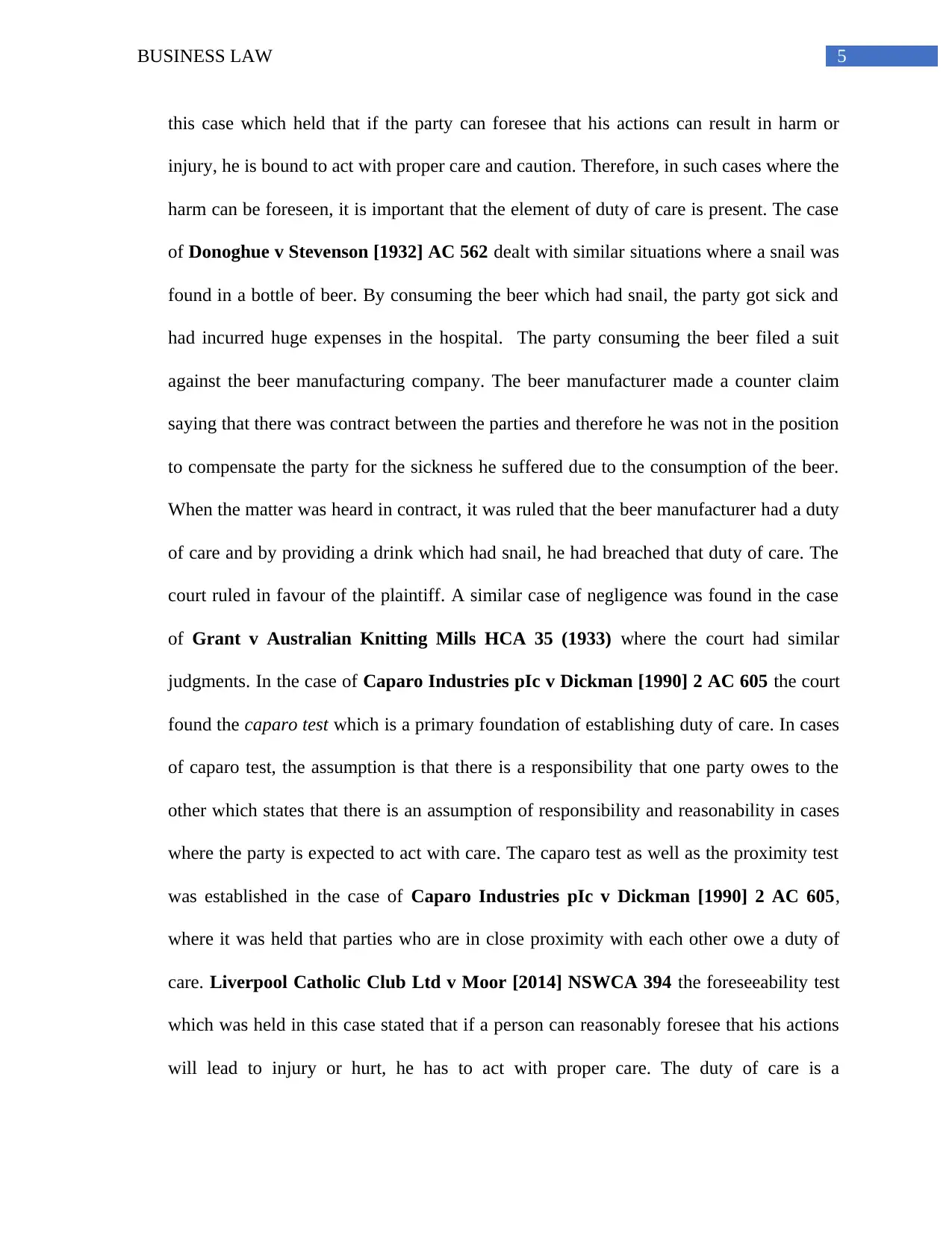
5BUSINESS LAW
this case which held that if the party can foresee that his actions can result in harm or
injury, he is bound to act with proper care and caution. Therefore, in such cases where the
harm can be foreseen, it is important that the element of duty of care is present. The case
of Donoghue v Stevenson [1932] AC 562 dealt with similar situations where a snail was
found in a bottle of beer. By consuming the beer which had snail, the party got sick and
had incurred huge expenses in the hospital. The party consuming the beer filed a suit
against the beer manufacturing company. The beer manufacturer made a counter claim
saying that there was contract between the parties and therefore he was not in the position
to compensate the party for the sickness he suffered due to the consumption of the beer.
When the matter was heard in contract, it was ruled that the beer manufacturer had a duty
of care and by providing a drink which had snail, he had breached that duty of care. The
court ruled in favour of the plaintiff. A similar case of negligence was found in the case
of Grant v Australian Knitting Mills HCA 35 (1933) where the court had similar
judgments. In the case of Caparo Industries pIc v Dickman [1990] 2 AC 605 the court
found the caparo test which is a primary foundation of establishing duty of care. In cases
of caparo test, the assumption is that there is a responsibility that one party owes to the
other which states that there is an assumption of responsibility and reasonability in cases
where the party is expected to act with care. The caparo test as well as the proximity test
was established in the case of Caparo Industries pIc v Dickman [1990] 2 AC 605,
where it was held that parties who are in close proximity with each other owe a duty of
care. Liverpool Catholic Club Ltd v Moor [2014] NSWCA 394 the foreseeability test
which was held in this case stated that if a person can reasonably foresee that his actions
will lead to injury or hurt, he has to act with proper care. The duty of care is a
this case which held that if the party can foresee that his actions can result in harm or
injury, he is bound to act with proper care and caution. Therefore, in such cases where the
harm can be foreseen, it is important that the element of duty of care is present. The case
of Donoghue v Stevenson [1932] AC 562 dealt with similar situations where a snail was
found in a bottle of beer. By consuming the beer which had snail, the party got sick and
had incurred huge expenses in the hospital. The party consuming the beer filed a suit
against the beer manufacturing company. The beer manufacturer made a counter claim
saying that there was contract between the parties and therefore he was not in the position
to compensate the party for the sickness he suffered due to the consumption of the beer.
When the matter was heard in contract, it was ruled that the beer manufacturer had a duty
of care and by providing a drink which had snail, he had breached that duty of care. The
court ruled in favour of the plaintiff. A similar case of negligence was found in the case
of Grant v Australian Knitting Mills HCA 35 (1933) where the court had similar
judgments. In the case of Caparo Industries pIc v Dickman [1990] 2 AC 605 the court
found the caparo test which is a primary foundation of establishing duty of care. In cases
of caparo test, the assumption is that there is a responsibility that one party owes to the
other which states that there is an assumption of responsibility and reasonability in cases
where the party is expected to act with care. The caparo test as well as the proximity test
was established in the case of Caparo Industries pIc v Dickman [1990] 2 AC 605,
where it was held that parties who are in close proximity with each other owe a duty of
care. Liverpool Catholic Club Ltd v Moor [2014] NSWCA 394 the foreseeability test
which was held in this case stated that if a person can reasonably foresee that his actions
will lead to injury or hurt, he has to act with proper care. The duty of care is a
⊘ This is a preview!⊘
Do you want full access?
Subscribe today to unlock all pages.

Trusted by 1+ million students worldwide
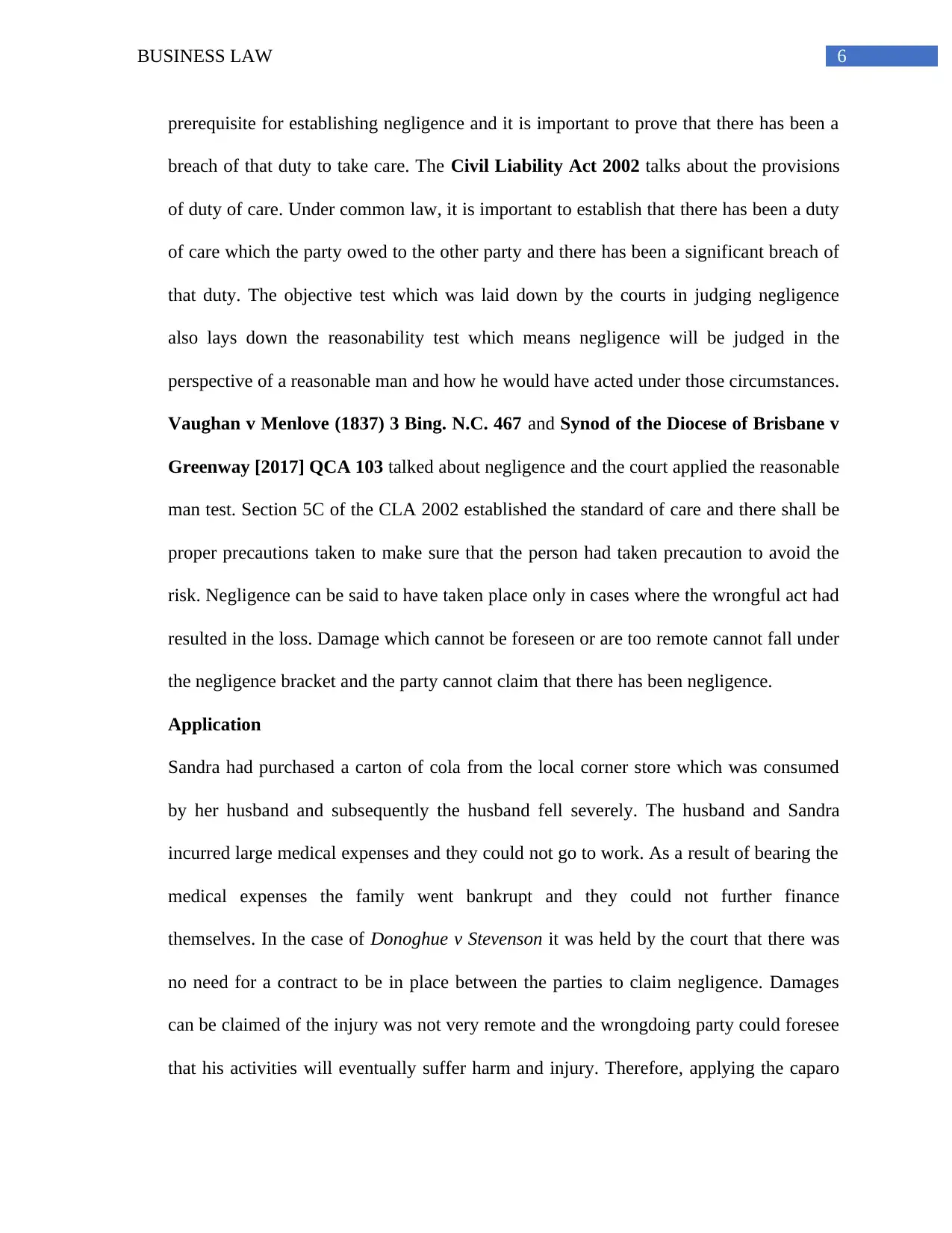
6BUSINESS LAW
prerequisite for establishing negligence and it is important to prove that there has been a
breach of that duty to take care. The Civil Liability Act 2002 talks about the provisions
of duty of care. Under common law, it is important to establish that there has been a duty
of care which the party owed to the other party and there has been a significant breach of
that duty. The objective test which was laid down by the courts in judging negligence
also lays down the reasonability test which means negligence will be judged in the
perspective of a reasonable man and how he would have acted under those circumstances.
Vaughan v Menlove (1837) 3 Bing. N.C. 467 and Synod of the Diocese of Brisbane v
Greenway [2017] QCA 103 talked about negligence and the court applied the reasonable
man test. Section 5C of the CLA 2002 established the standard of care and there shall be
proper precautions taken to make sure that the person had taken precaution to avoid the
risk. Negligence can be said to have taken place only in cases where the wrongful act had
resulted in the loss. Damage which cannot be foreseen or are too remote cannot fall under
the negligence bracket and the party cannot claim that there has been negligence.
Application
Sandra had purchased a carton of cola from the local corner store which was consumed
by her husband and subsequently the husband fell severely. The husband and Sandra
incurred large medical expenses and they could not go to work. As a result of bearing the
medical expenses the family went bankrupt and they could not further finance
themselves. In the case of Donoghue v Stevenson it was held by the court that there was
no need for a contract to be in place between the parties to claim negligence. Damages
can be claimed of the injury was not very remote and the wrongdoing party could foresee
that his activities will eventually suffer harm and injury. Therefore, applying the caparo
prerequisite for establishing negligence and it is important to prove that there has been a
breach of that duty to take care. The Civil Liability Act 2002 talks about the provisions
of duty of care. Under common law, it is important to establish that there has been a duty
of care which the party owed to the other party and there has been a significant breach of
that duty. The objective test which was laid down by the courts in judging negligence
also lays down the reasonability test which means negligence will be judged in the
perspective of a reasonable man and how he would have acted under those circumstances.
Vaughan v Menlove (1837) 3 Bing. N.C. 467 and Synod of the Diocese of Brisbane v
Greenway [2017] QCA 103 talked about negligence and the court applied the reasonable
man test. Section 5C of the CLA 2002 established the standard of care and there shall be
proper precautions taken to make sure that the person had taken precaution to avoid the
risk. Negligence can be said to have taken place only in cases where the wrongful act had
resulted in the loss. Damage which cannot be foreseen or are too remote cannot fall under
the negligence bracket and the party cannot claim that there has been negligence.
Application
Sandra had purchased a carton of cola from the local corner store which was consumed
by her husband and subsequently the husband fell severely. The husband and Sandra
incurred large medical expenses and they could not go to work. As a result of bearing the
medical expenses the family went bankrupt and they could not further finance
themselves. In the case of Donoghue v Stevenson it was held by the court that there was
no need for a contract to be in place between the parties to claim negligence. Damages
can be claimed of the injury was not very remote and the wrongdoing party could foresee
that his activities will eventually suffer harm and injury. Therefore, applying the caparo
Paraphrase This Document
Need a fresh take? Get an instant paraphrase of this document with our AI Paraphraser
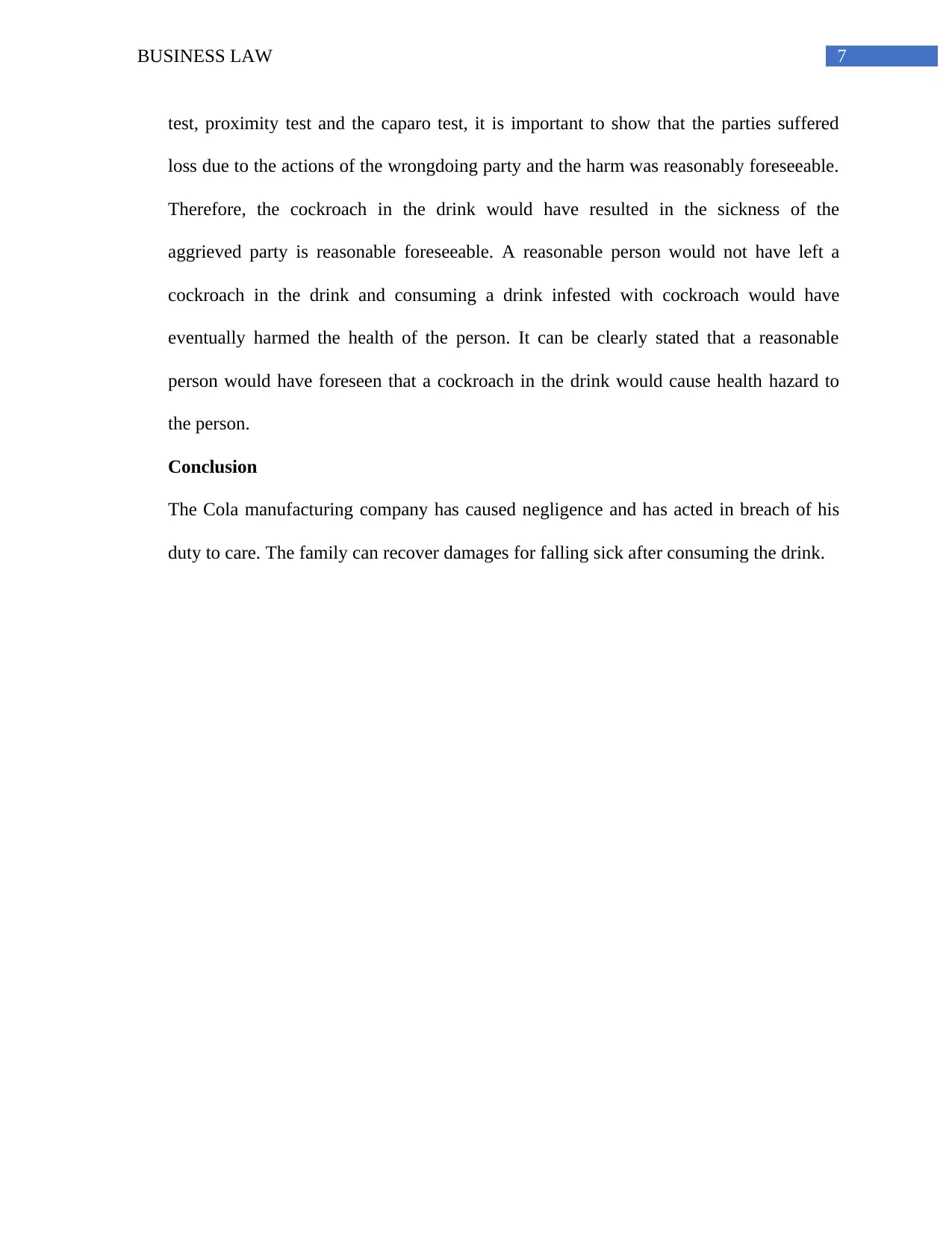
7BUSINESS LAW
test, proximity test and the caparo test, it is important to show that the parties suffered
loss due to the actions of the wrongdoing party and the harm was reasonably foreseeable.
Therefore, the cockroach in the drink would have resulted in the sickness of the
aggrieved party is reasonable foreseeable. A reasonable person would not have left a
cockroach in the drink and consuming a drink infested with cockroach would have
eventually harmed the health of the person. It can be clearly stated that a reasonable
person would have foreseen that a cockroach in the drink would cause health hazard to
the person.
Conclusion
The Cola manufacturing company has caused negligence and has acted in breach of his
duty to care. The family can recover damages for falling sick after consuming the drink.
test, proximity test and the caparo test, it is important to show that the parties suffered
loss due to the actions of the wrongdoing party and the harm was reasonably foreseeable.
Therefore, the cockroach in the drink would have resulted in the sickness of the
aggrieved party is reasonable foreseeable. A reasonable person would not have left a
cockroach in the drink and consuming a drink infested with cockroach would have
eventually harmed the health of the person. It can be clearly stated that a reasonable
person would have foreseen that a cockroach in the drink would cause health hazard to
the person.
Conclusion
The Cola manufacturing company has caused negligence and has acted in breach of his
duty to care. The family can recover damages for falling sick after consuming the drink.
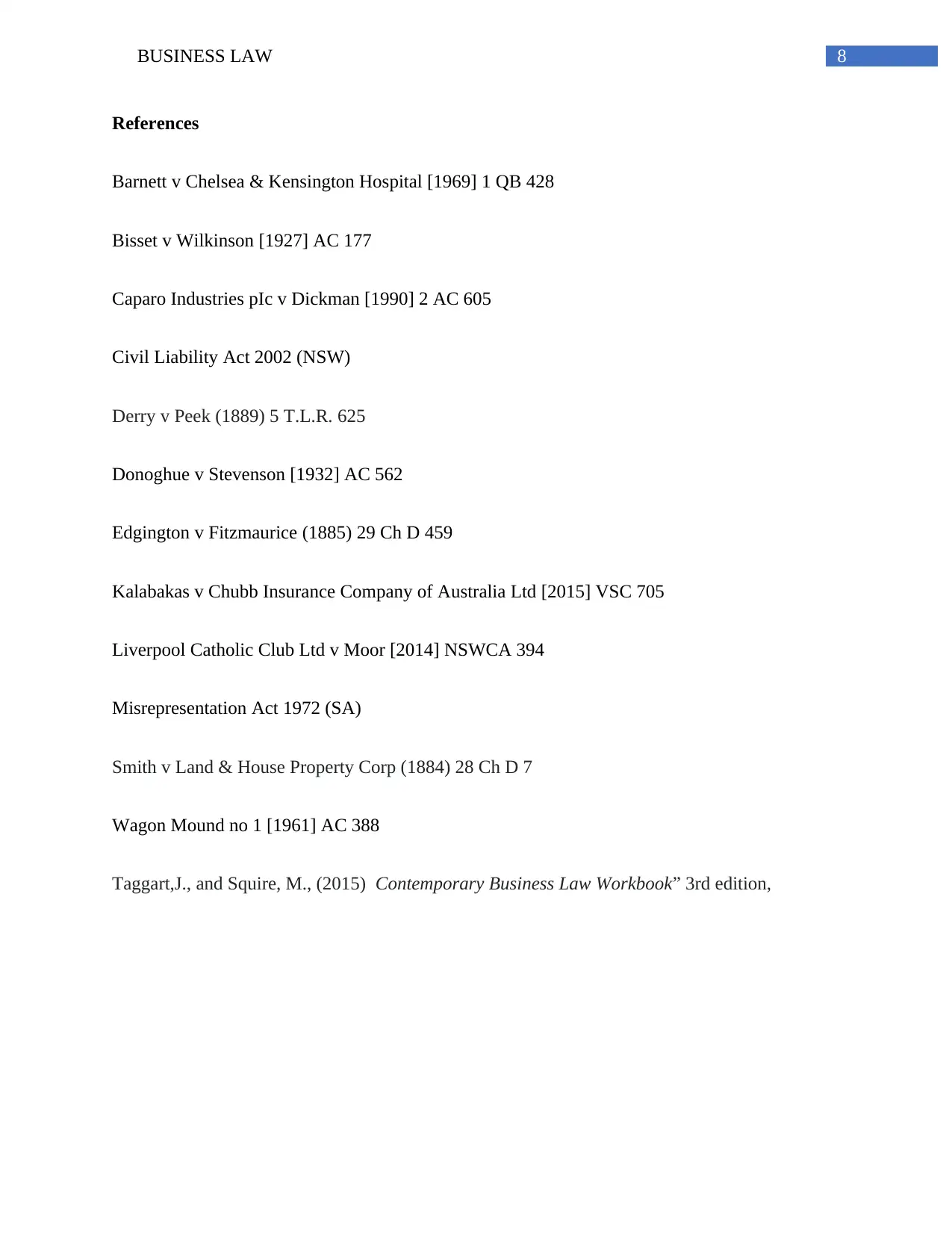
8BUSINESS LAW
References
Barnett v Chelsea & Kensington Hospital [1969] 1 QB 428
Bisset v Wilkinson [1927] AC 177
Caparo Industries pIc v Dickman [1990] 2 AC 605
Civil Liability Act 2002 (NSW)
Derry v Peek (1889) 5 T.L.R. 625
Donoghue v Stevenson [1932] AC 562
Edgington v Fitzmaurice (1885) 29 Ch D 459
Kalabakas v Chubb Insurance Company of Australia Ltd [2015] VSC 705
Liverpool Catholic Club Ltd v Moor [2014] NSWCA 394
Misrepresentation Act 1972 (SA)
Smith v Land & House Property Corp (1884) 28 Ch D 7
Wagon Mound no 1 [1961] AC 388
Taggart,J., and Squire, M., (2015) Contemporary Business Law Workbook” 3rd edition,
References
Barnett v Chelsea & Kensington Hospital [1969] 1 QB 428
Bisset v Wilkinson [1927] AC 177
Caparo Industries pIc v Dickman [1990] 2 AC 605
Civil Liability Act 2002 (NSW)
Derry v Peek (1889) 5 T.L.R. 625
Donoghue v Stevenson [1932] AC 562
Edgington v Fitzmaurice (1885) 29 Ch D 459
Kalabakas v Chubb Insurance Company of Australia Ltd [2015] VSC 705
Liverpool Catholic Club Ltd v Moor [2014] NSWCA 394
Misrepresentation Act 1972 (SA)
Smith v Land & House Property Corp (1884) 28 Ch D 7
Wagon Mound no 1 [1961] AC 388
Taggart,J., and Squire, M., (2015) Contemporary Business Law Workbook” 3rd edition,
⊘ This is a preview!⊘
Do you want full access?
Subscribe today to unlock all pages.

Trusted by 1+ million students worldwide
1 out of 9
Related Documents
Your All-in-One AI-Powered Toolkit for Academic Success.
+13062052269
info@desklib.com
Available 24*7 on WhatsApp / Email
![[object Object]](/_next/static/media/star-bottom.7253800d.svg)
Unlock your academic potential
Copyright © 2020–2025 A2Z Services. All Rights Reserved. Developed and managed by ZUCOL.





